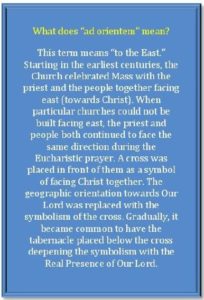Read the letter below, in which Fr. Patrick explains “ad orientem.”
Dear Parishioners and Friends,

This year during Lent I will be celebrating the 10 a.m. Sunday Masses “ad orientem.” Most of us are accustomed to the priest facing the people at Mass, but for Mass celebrated ad orientem, the priest and the people face the same direction at specific points. I also plan to celebrate Mass in this way for the Thursday 7 a.m. daily Mass and for the Novena Masses for the Faithful Departed. However, the other Masses will be celebrated in the usual manner.
Before I explain why, I want to make it very clear that this is not the “pre-Vatican II” Mass (now what we call the “Extraordinary Form” of the Mass). While there is still a place for the Extraordinary Form of the Mass and there are still people who prefer to attend that form of the Mass, I am not planning to celebrate it here. At times, we do have some Latin brought into the Mass. This includes Mass parts, antiphons, or special hymns. However, I am planning to continue celebrating the Mass in English.
So, why would the priest celebrate Mass ad orientem (facing the same direction as the people)? First, ad orientem is one of the options! It is not just part of the “pre-Vatican II Mass.” The priest has the option, in the current form of the Mass, either to celebrate facing the people or facing the Lord with the people. Catholics today can be enriched by experiencing the current form of the Mass both ways. In fact, facing the same direction as the people is the most historically consistent way of celebrating the Mass (see sidebar).
Second, ad orientem expresses the intention of the action at different moments throughout the Mass. When Mass is celebrated ad orientem, there are certain points when the priest turns towards the people. At those points, the priest is in a dialogue with the people. When the priest faces the same direction as the people, however, we are reminded that the words spoken are not part of a dialogue but are addressed directly to God. This helps us to know how to focus our thoughts and prayers at different moments of the Mass.
This leads to the third point: ad orientem reminds us of the sacrificial character of the Mass. Every time we come to Mass Jesus’ sacrifice on Calvary is present to us. Even though only a priest can celebrate the Mass, each of the faithful is called to join the priest in offering their lives along with Jesus to the Father. When the priest and the congregation all face the same direction, they symbolize the fact that the priest is not the only one making the offering. It reminds us that the people are in union with the priest as they offer their own sacrifices to God. At Mass the priest says, “Pray brothers and sisters that my sacrifice and yours may be acceptable to God the Father almighty.” By praying in the same direction as the priest, you are physically reminded that the offering is not only made by the priest but by each member of the faithful present. In this way, we turn to the Lord as a priestly people to offer our lives with Jesus to the Father. What does “ad orientem” mean? This term means “to the East.” Starting in the earliest centuries, the Church celebrated Mass with the priest and the people together facing east (towards Christ). When particular churches could not be built facing east, the priest and people both continued to face the same direction during the Eucharistic prayer. A cross was placed in front of them as a symbol of facing Christ together. The geographic orientation towards Our Lord was replaced with the symbolism of the cross. Gradually, it became common to have the tabernacle placed below the cross deepening the symbolism with the Real Presence of Our Lord.
I hope that you have a chance to experience this here during Lent. I also look forward to hearing your feedback as I discern whether we would continue this practice for the 10 a.m. Mass beyond the season of Lent. My hope in trying this out as a parish is to provide new ways for you to encounter the living God through the Holy Mass.
Blessings,
Fr. Patrick Burns
